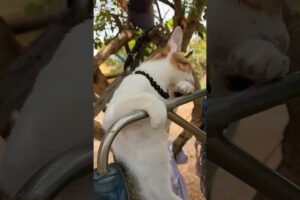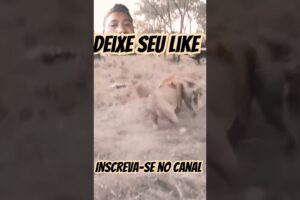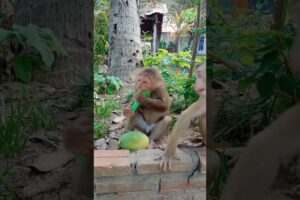
Description
### INFORMATION on this video TO READ ABSOLUTELY ###
### INFORMATIONS sur cette vidéo A LIRE ABSOLUMENT ###
About twenty kilometers south from Equator line and five or six kilometers from Atlantic Ocean beaches, in an unprotected area of the Gabonese forest, Michel Guiss DJOMOU, Anne-Marie and Xavier HUBERT-BRIERRE have placed large mirrors (240cm x 120cm) with front each of them several trap cameras to shoot from different angles, behaviour of wild animals face their reflection.
For many years studies on self-recognition are made in the laboratory with captive animals. The daily presence of humans (researchers, veterinaries) beside them can have somewhat changed their behavior.
In the forest near Nyonié, animals in total freedom (not cloistered in a secure national park or reserve), can go and stay day and night, before these “intruders” as they wish.
A trail through a forest is a boon for animals. It allows for easier growth than in the forest undergrowth impeded by creepers, brambles, bushes and dead trees. Implantation of some of these mirrors along a track optimizes number of animal movements before them.
Other mirrors were mounted under fruit trees highly appreciated by the animals of the forest and therefore very visited.
This mirror was fixed under a Coula Edulis, locally called “hazel tree” that the nuts in the shell four times bigger than hazelnuts temperate regions of the northern hemisphere.
The nut is a round drupe 3-4 cm in diameter, with flesh surrounding the extremely hard kernel shell.
– Greedily swallowed by elephants (Loxodonta africana cyclotis / The African forest elephant / Assala) or crushed between their imposing molars before spitting out the shell.
– Savoured by mandrills (Mandrillus sphinx) and bushpigs (Potamochoerus porcus / Red river hogs) broken between their powerful jaws.
– Peeled by chimpanzees (Pan troglodytes / the common chimpanzees) their incisors and lips. They eat only the outer flesh because their fragile teeth cannot serve as nutcrackers and unlike their cousins in Ivory Coast, they have not learned to use a stone hammer and anvil to crack open the nut.
The leopard (Panthera pardus pardus) around the mirror to taste a mandrill nourished with almonds.
Humans appreciate also these nuts: Their kernels are often for sale at roadside.
———————————————
A une vingtaine de kilomètres au sud de l’Equateur et à cinq ou six kilomètres des plages de l’Océan Atlantique, dans une zone non protégée de la forêt gabonaise, Michel GUISS DJOMOU, Anne-Marie et Xavier HUBERT-BRIERRE ont placé des grands miroirs (240cm x 120cm) avec devant chacun d’eux plusieurs pièges photographiques pour filmer, sous différents angles, les réactions des animaux sauvages face à leur reflet.
Depuis de nombreuses années des études sur la reconnaissance de soi sont faites en laboratoire avec des animaux captifs. La présence journalière des humains (chercheurs, soigneurs) à leur côté peut avoir quelque peu modifié leurs comportements.
Dans la forêt, à Nyonié, les animaux, en totale liberté (pas cloitrés dans une réserve protégée ou parc national), peuvent se rendre et rester de jour comme de nuit, devant ces « intrus » comme bon leur semble.
Une piste traversant une forêt est une aubaine pour les animaux. Elle permet une progression plus aisée que dans la forêt au sous-bois entravé par les lianes, ronces, fourrés et arbres morts. L’implantation de certains de ces miroirs le long d’une piste permet d’optimiser le nombre de passages d’animaux devant eux. D’autres miroirs ont été montés sous des arbres fruitiers très appréciés par les animaux de la forêt et donc très visités. C’est par exemple le cas du miroir M6 placé sous un Coula Edulis, appelé localement « noisetier » dont les noix sont constituées d’une coque contenant une amande quatre fois plus grosse que les noisettes (au goût très proche) des régions tempérées de l’hémisphère nord :
Ses noix sont des drupes rondes de 3-4 cm de diamètre, dont la chair entoure une coque extrêmement dure contenant l’amande.
Goulument avalées ou écrasées par les éléphants entre leurs molaires imposantes avant de cracher la coquille.
Savourées par les mandrills et les potamochères après avoir été brisées entre leurs puissantes mâchoires.
Pelées par les chimpanzés entre leurs incisives et leurs lèvres. Ils ne mangent que la chair extérieure parce que leurs dents fragiles ne peuvent pas servir de casse-noix et contrairement à certains de leurs cousins de Côte d’Ivoire, ils n’ont pas appris à utiliser des pierres comme marteau et une enclume pour extraire l’amande.
Le léopard rôde fréquemment autour du miroir pour « se faire » un jeune singe mandrill nourri aux noisettes.
Les humains apprécient aussi ces noix : Leurs amandes sont souvent en vente au bord de la route.
source







Love elephants ?
Which animals reaction was your favorite? Mines are the elephants. Strange how the jungle can share so many different species.
Anyone else love Gabonese jungle? Great video thanks for sharing!
Okay the pigs(wild boar) might be greedy,…hence, the term greedy pig! Or,..maybe they're just…enthusiastic!
They're cute though. They have skinny legs and cute butts! Funny and cute!
Elephant's aren't like, "It's every elephant for himself!" They look after each other, care for each other, and share. How dare you call that elephant greedy! Maybe you're greedy! …just kiddin'!
I would not say greed, but natural hunger. Elephants aren't greedy.
ตัวใหญ่ซะเปล่าไม่รู้เรื่อง
I don't believe I would call their trips to the mirror, where the walnut is, greed. I would call it hunger. Greed and hunger, have two totally different meanings. And hunger is what draws them to the walnut…not greed.
What is it about elephant's eyes? They are so mysterious
Fuck. I could have swore I just saw another elephant.
I’m no English teacher, but I wouldn’t use the word greed. I think that’s the wrong term. I still enjoyed the video.
I wouldn't call hunger greed.
The quality of this video is so good that you could think that it is not genuine. I am impressed. Beautiful. Thank you for this great clip
Like why say out of greed ?Their hungry… it's there they eat !
Not one of them was remotely bothered,
ANIMAIS, CIISAS LINDAS QUE DEUS CRIOU, DEVEM SER RESPEITADOS
오잉 카메라 잇는거 눈치 챘네
Very nice video.
So I guess they never see their reflection in the watering holes. I wonder if it's against animal code to look down in watering holes. I wonder if it's too dangerous to look down in the animal kingdom. Maybe there aren't any natural mirrors anywhere. I wonder if they put mirrors in zoos. I wonder if the animals were wondering why its reflection didn't have a scent. I wonder if any of the animals had mating on its mind. I wonder if that was that my first reaction ? ? If it was. I wonder what the animals thought whenever they took the mirrors away. I wonder what the animals thought when it saw them take it away. Why weren't the elephants aggressive? Why didn't the elephant knock the mirror down? I wonder if birds are aware of their own reflections.
Acho um desperdício de recurso que pode ir utilizar uma coisa bem útil um grande desperdício porque custa caro
That is alot of different species
The pigs look so delicious.
Кого там только нет. ?
Out of greed, eh? I get it, but greed is probably the wrong term…
Some nice fruit down there
well most of them never really give a damn. ?
El elefante se da cuenta que lo estan filmando…
Elephant is too smart.
WoW!!!
Such varied wildlife and most did not notice or were not curious about the mirror! I enjoyed the animals just going on about their business.
was 2 no I'll effect the elephants have a keen sense of smell, the rest of the animals know of that mirror its been there 2 long
1. They can smell the humans who set it up
2. It didn't use to be there.
3. One elephant even located the camera.
They'll be this cautious until the smell is gone of course
Not so interesting. ..
Love elis…….lovem all
Nice one
Mirror? Or billboard! No reflections?
ช้างไทยสวยกว่าเยอะ นี่ผมดูนึกว่าตัวชะมด
Can't creatures see their reflections in water and if so why can't they understand mirrors?
Elephant #1, " I know that elephant from somewhere, I just can't for the life of me remember her name. Totally escapes my memory. Oh well, it'll come to me later, much later.
.30 elephant says, "oh no, your not tricking me into joining the circus, oh hell no".